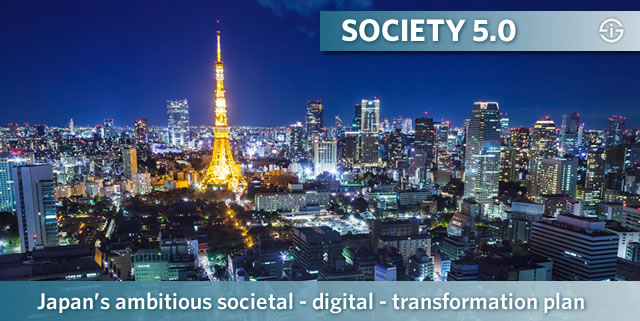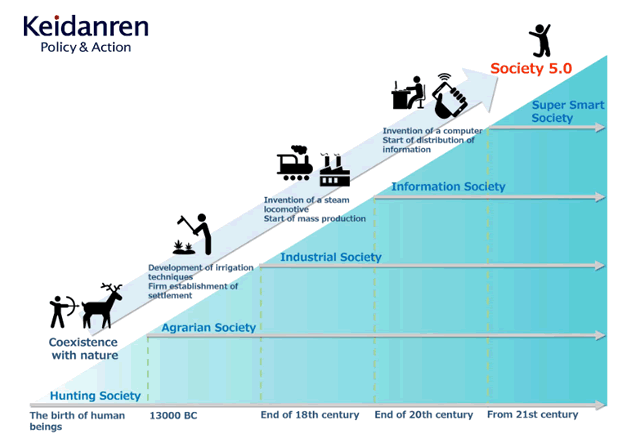What better place to present a vision for a ‘super-smart society’ to the West, which you call Society 5.0 than Germany, the land of Industrie 4.0 or Industry 4.0?
That’s exactly what CeBIT 2017 partner country Japan is doing at the annual gathering of the German, and increasingly international, tradeshow/conference. Note: Japan doesn’t launch the Society 5.0 vision at CeBIT, it already shared that vision in 2016.
Japan has its particular challenges and just as Industry 4.0 is the digital transformation of manufacturing, Society 5.0 aims to tackle several challenges by going far beyond just the digitalization of the economy towards the digitalization across all levels of the Japanese society and the (digital) transformation of society itself. And that has some pretty far-reaching consequences as you’ll read.

At an event at CeBIT 2017, “Society 5.0 – Another Perspective”, the road to that super-smart society turned out to be paved with an important role for technologies in areas such as the Internet of Things, AI (artificial intelligence), cyber-physical systems, VR/AR, Big Data (analytics), the full list. Yet, it’s not just about technologies.
A digital society for an ageing population
One of the particular challenges for Japan is the ageing population. While ageing doesn’t mean becoming a problem it does come with some challenges on various levels, although some of those can (and will) become less of a challenge as a result of smart approaches, enabled by technology but shaped by smart people.
While an ageing population is a challenge for most countries it particularly is so for Japan. As we mentioned in our article on the digital transformation of healthcare, Japan by far has the ‘oldest’ population with 26.3 percent being over 65 years young.
To put this number in perspective: it is expected that across the globe over 20 percent of the population will be over 60 years young by….2050. Essentially this means, apart from the amazing numbers in Japan today, that all countries should watch at what Japan is doing and how this Society 5.0 works out in reality as we’ll have a lot of lessons to learn from that ageing population perspective – and the many others you’ll discover below.
In healthcare, not just the health aspect of dealing with more chronic diseases, which come with older age, but mainly the ways healthcare is reorganized in function of this ageing population reality, digital transformation efforts and the rethinking of care, including technologies, are partially driven by the fact that people on average simply get older.
Society 5.0: breaking down five walls
While health and other aspects of society that are impacted by ageing populations (think mobility, the ways we live in practice, housing and so forth), Society 5.0 for Japan is not about ageing alone. Otherwise it wouldn’t be dubbed Society 5.0.
Among the other challenges Japan, more than many other countries, has to deal with are natural disasters and pollution. To deal with these and other challenges, the super-smart society has to offer the way.
In order to achieve this, Keidanren (Japan Business Federation) published a vision paper (an ‘outline’) in which it describes that tackling the challenges which we described – and others – will require the breaking down of five walls. Indeed, five as in Society 5.0.
However, just as in Industry 4.0 as the fourth industrial revolution, Society 5.0 is also depicted as an evolution in five societal stages in the position paper of Keidanren: 1) the hunting society, 2) the agrarian society, 3) the industrial society, 4) the information society, and, 5) the super-smart society a.k.a. Society 5.0.

What Japan essentially does is taking the digitalization and transformation dimension, which is mainly happening on the level of individual organizations and parts of society to a full national transformational strategy, policy and even philosophy level. It’s the furthest reaching plan we’ve ever seen in this regard.
The 5 walls to ‘break through’ in moving to Society 5.0
So, what are these 5 walls and how does Japan intend to take them down?
The wall of the Ministries and Agencies.
With the need of, quoting from the Keidanren position paper, a “formulation of national strategies and integration of government promotion system”. This includes the architecting of a ‘handy IoT system’ and a think-tank function.
The wall of the legal system
Whereby laws need to be developed to implement advanced techniques. In practice this would also mean regulatory reforms and a push of administrative digitization (good news for all the document capture and information management people out there).
The wall of technologies
The quest for the formation of the ‘knowledge foundation’. It’s clear that actionable data plays a foundational role here as do all technologies/areas to protect and leverage it, from cybersecurity to robotics, nano, bio and systems technology. The paper also mentions a serious R&D commitment on various levels.
The wall of human resources
Educational reform, IT literacy, broadening the available human resources with specializations in advanced digital skills are just a few of them. Interesting: if the paper becomes reality, Japan will open its doors for highly skilled professionals in areas such as security and data science. At least as interesting: “the promotion of women’s participation to discover potential talents”.
Social implications, ethics and social acceptance by all stakeholders
Wait, that’s only 4 walls. Indeed. The fifth one is pretty bold and very far-reaching: “the wall of social acceptance”. This is the most society-related aspect of all.
The ‘outline’ by Keidanren doesn’t just emphasize the need of a social consensus but also of a thorough look at social implications and even ethical issues, among others with regards to the man-machine relation and, as said, even philosophical matters such as defining what individual happiness and humanity means.
Obviously, in practice, Industry 4.0 and organizations overall will be major components in Society 5.0, yet it’s not the industry alone: it’s about all stakeholders, including citizens, governments, academia and so forth.
Whether such a vast societal change will work and the wall of social acceptance will be broken down is a question that will be answered in the future. Making predictions in this regard would be Western arrogance from our part and a big mistake. So: who knows? And is this a model we could envision in other parts of the world?
You can read more about it all in the Keidanren outline, entitled ‘Toward realization of the new economy and society – Reform of the economy and society by the deepening of “Society 5.0” (PDF opens) and on this CeBIT page, where the event was announced.
Top image: Shutterstock – Copyright: leungchopan – All other images are the property of their respective mentioned owners.

